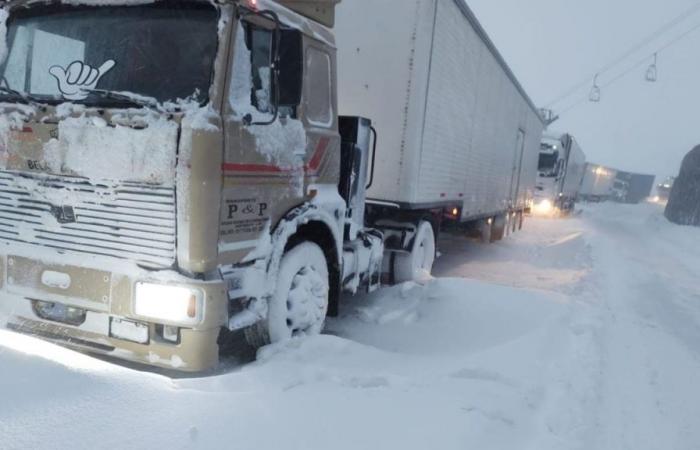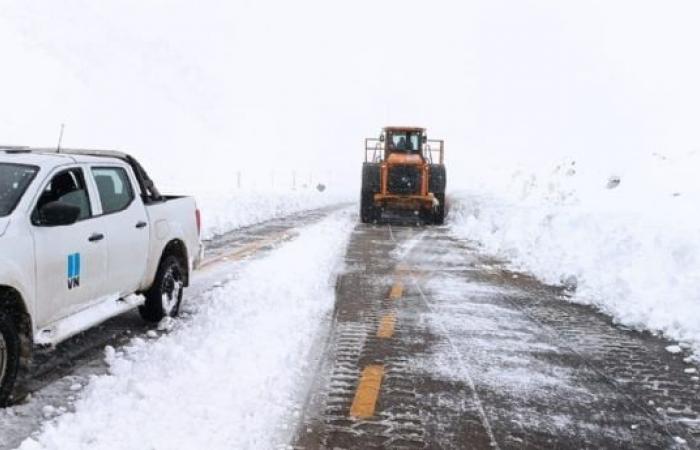Uspallata The town has just under 4,000 permanent inhabitants. But for the past 20 days, there have been 1,000 more people living there. They live as best they can, in the trucks that form a “town on wheels” at the edge of this mountain village. There are 1,000 people who wander around and speak different languages and have diverse dialects and accents.
Uspallata It is a familiar place because it also depends on transportation logistics, since it is the largest place before crossing into Chile and Customs is there. But the impact of sharply increasing its population is felt the same. Something similar happens in the eastern area of Mendoza: small towns that have nomadic inhabitants who spend their days waiting for the airport to open. Christ the Redeemer Pass. The trucks have a certain comfort, but the wait is tedious. “They have even had to receive psychological assistance due to their anguish,” they explained from the Ministry of Health of Mendoza. In Mendoza there are more than 2,000 truck drivers throughout the corridor, but the shock wave spreads to neighboring provinces. In total there are more than 5 thousand who, they believe, are waiting.
The inhabitants of the nomadic village have acute health problems. Poor diet, poor general conditions. Two truck drivers died while waiting to cross. One of them died of cardiac arrest. He was alone inside his truck and no one could tell that he was in trouble. It wasn’t until three days later that they discovered that he had died. Fernando Guccioni Sousa Vieira was waiting in the same area. During a routine checkup they discovered that he had respiratory problems and he was admitted to the Uspallata Hospital. He got worse, they transferred him to a more complex center because the pneumonia he had worsened and he died. In addition to the two dead, another 300 people were assisted.
The pass has been closed for 17 days, but many have been waiting for 21 days, since since June 8 there has only been one opening day. “There are about 950 truck drivers of different nationalities. Paraguayans, Bolivians, Brazilians, Chileans, Uruguayans and Argentines. To date, 82 patients with some problem have been treated. Of that group, 12 had to be transferred, most due to respiratory symptoms, hypertension and some decompensation due to underlying problems. Two were hospitalized. One was discharged and another had been referred and died at the Perrupato Hospital,” explained the director of the Uspallata hospital, Marcelo Luconi. In the East, more than 200 people were treated and they even brought in a psychologist to address the anxiety and depression problems detected in some of the truck drivers. Even undiagnosed chronic health problems were detected, such as diabetes and hypertension.
Complaints
Complaints and pressure grow. Transportation businessmen assure that the logistics to manage the contingency does not work quickly and, thus, the good weather windows cannot be taken advantage of. In the middle there are at least 4 national organizations involved (Gendarmery, Roads, Immigration and Customs) that have received cuts in their resources. And a broken relationship with Chilifollowing the conflicts that arose due to the statements and actions of Ambassador Jorge Faurie, among other things. That is why the link is, they say, strictly formal, through official letters and with a climate as cold as the mountain range that separates the two countries.
The corridor, which has Route 7 as its center, was in the middle of a redesign plan, with works financed by the IDB that had planned stages. But now that schedule is on hold due to the suspension of works determined by the National Government. The intervention included the caracoles tunnel, improvements in the avalanche zone, improvement and widening of roads and other strategic works. The IDB granted a loan of 200 million dollars for these works and required a national counterpart of 15 million dollars in a first stage. But the total plan for capacity expansion and security improvements in the accesses to Paso Cristo Redentor foresees a total amount of the work of US$ 531.9 million, of which the IDB had committed US$ 324.3 million, but the Nation was to contribute the remaining 39%.

In the logistics sector there are doubts and they believe that the resources allocated are not optimal. They even suspect that National Highways is suffering from the “chainsaw” effect. In response to the query of MDZfrom that organization they limited themselves to reporting through a written report. “National Roads The DNV has been working permanently to allow for rapid rehabilitation as conditions allowed. In fact, and taking into account the last interruption from 6/13, during that period the work of the DNV allowed for the transitability of various high mountain localities, depending on the day and the prevailing conditions,” they explained. According to that detail, they worked in a rotating shift of operators “which was doubled during the last few days to optimize the clearing performance.” “To achieve this goal, the UE Uspallata worked with various types of equipment according to the requirement and task plan. Large pneumatic and tracked dozers, a large loader, a self-propelled snow blower, motor graders, trucks for spreading antifreeze solution and a solid salt spreader were used. This does not include the equipment that remains on standby and as backup for reinforcement in the work” they detailed.
On average, the Passed It is usually closed for about 30 days, although there were years when it was greatly exceeded. Last year, for example, it was closed for almost 60 days. While the Pass is closed, the movement of High Mountain specialists does not stop. On the Argentine side there are 40 snow avalanche channels and 90 on the Chilean side. This is where the most complex problems occur. The curious thing is that as time went by the problems worsened. Even in recent years, traffic on Route 7 has grown strongly, exceeding forecasts.
About 2,000 trucks cross the border every day when conditions permit. As has happened in the past, Mendoza residents believe that the problem is being underestimated by not taking into account that Cristo Redentor is the country’s main land crossing, linking the Atlantic with the Pacific. “It’s as if they closed the Panama Canal. In other places the whole country would be waiting,” they complain. Mendoza.
The avalanches that occurred on the Chilean side delayed the opening. A 10-day window of good weather is expected. The nomadic people of truck drivers are excited.




